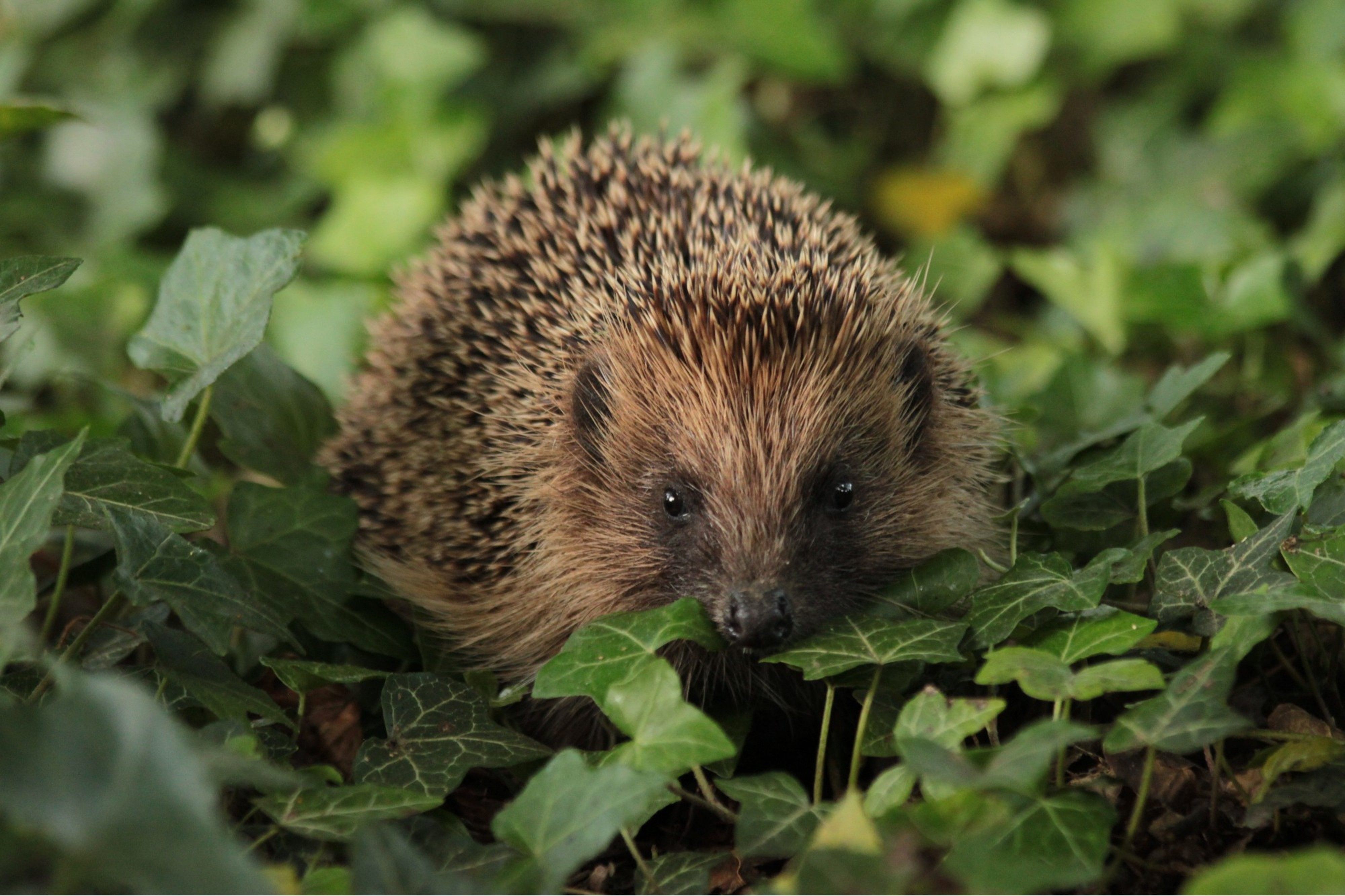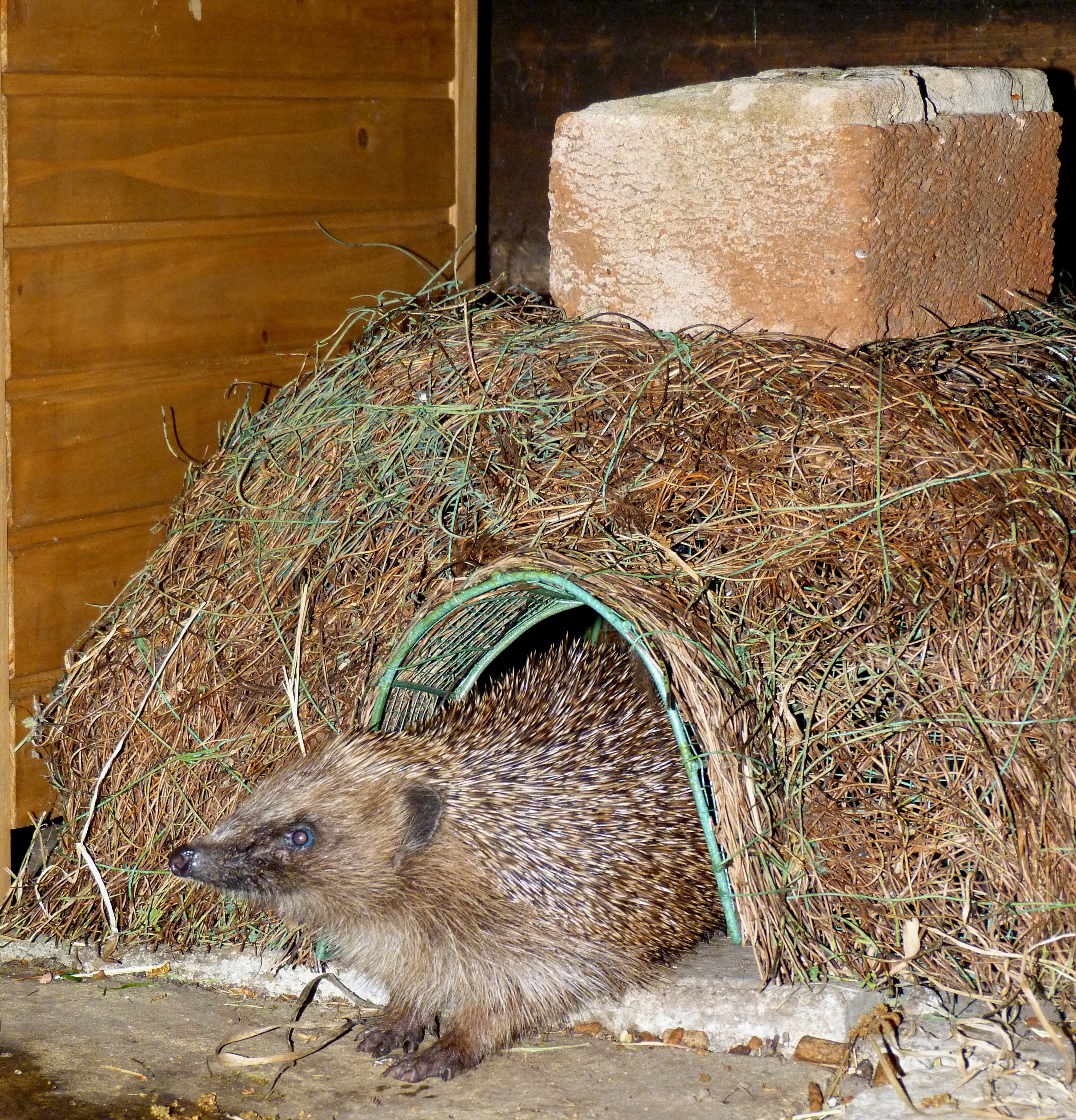London Wants Its Hedgehogs Back
How do you make a city more hedgehog-friendly? Step 1: Drill some holes.
If you happen to spot a small hole in the bottom of a fence or brick wall in Barnes, a neighborhood in southwest London, there’s a good chance that you’ve stumbled upon a hedgehog crossing, and that Michel Birkenwald is responsible for it.
A jeweller by trade, Birkenwald has become one of London’s most enthusiastic engineers of infrastructure for animals. He founded and self-financed Barnes Hedgehogs. The group drills the holes for free and generally advocates for the welfare of wild hedgehogs. Once Birkenwald has crafted a passage, he usually affixes a sign reading “Hedgehog Highway,” with the creature’s spiky silhouette.
Even with a diamond drill tip, the work can be slow going. Victorian bricks are tough, and it can take upwards of an hour to carve a shape roughly the size of a CD—the smallest circumference that can comfortably accommodate the girth of “a porky hedgehog,” says Emily Wilson, of another advocacy group, Hedgehog Streets.
Whatever Birkenwald lacks in academic credentials—he doesn’t have much background in environmental science or zoology—he makes up for in earnestness. “I am just an average guy who decided to help one of our most adorable mammals,” he says.

Britain’s hedgehogs, for all their iconic cuteness, have fallen on prickly times. Their predilection for green spaces is written into their name—porcine snout and penchant for hedgerows. The trouble is that those rows are fewer and farther between than they once were, for a variety of reasons, and resident hedgehog populations—in the countryside and in their urban habitat—have suffered as a result.
It’s difficult to be precise about the decline, because hedgehogs throw up numerous obstacles to a reliable census. They’re nocturnal and they bed down in compost, leaves, and other nooks and crannies. They’re more often reported as roadkill than as living creatures. But when Hedgehog Street compiled data on hedgehogs from three surveys of garden sightings and road fatalities conducted by the British Trust for Ornithology and the People’s Trust for Endangered Species, patterns emerged. (Hedgehog Street also launched its own tracking tool, a crowdsourced map that updates in real time.)
In the 1950s, some estimates placed the British hedgehog population at 30 million, though that number is generally accepted to be rough and inflated. A 1995 study put the number closer to 1.5 million across England, Scotland, and Wales. Over the last two decades, Wilson says, hedgehogs have declined by roughly fifty percent in the countryside and by a third in urban enclaves.
Part of the problem is that farmers don’t much care for the scruffy environs that hedgehogs thrive in. By yanking out hedges, clearing scrub, and tidying up piles of dead wood, Wilson says—all part of what she describes as a yield-maximizing, profit-driven quest for “agricultural intensification”—they’ve made the land less welcoming to the erinaceids.

There is some cheerier news for urban hedgehogs, though. Their rate of decline appears to be slowing. “It’s implying that hedgehogs are basically moving into our towns and cities,” Wilson says. “They’re quite sturdy, and able to live alongside us quite well, as long as we make space for them and link green spaces together.”
But we don’t make it easy on them. The infrastructure built up and laid down to make our lives easier often has the opposite effect for those who slither, flutter, or scuttle. Researchers have found that urban animals often behave differently than their more rural counterparts, and human activity shrinks animals’ ranges—they move less when we’re around. Cities can resemble oceans of concrete speckled with glass islands and mere flecks of green. “How does an animal get from one [green space] to the next unless it’s a bird that can fly?” Wilson asks.
Hedgehogs need help from their human neighbors, Wilson says. Some 47,000 people have signed up to be “hedgehog champions” with Hedgehog Street, and take steps such as setting out piles of logs or leaves and letting some corners become overgrown. The group also advocates putting out little buffets of meaty dog or cat food, cat biscuits, and a shallow dish of water—but not milk. (Hedgehogs are omnivorous, but lactose intolerant.)

In addition to the holes and tunnels that Birkenwald drills in fences and walls, Hedgehog Streets is in talks with fencing companies and developers to manufacture and install dividers with predrilled holes. Though Wilson says some people worry about their dogs wriggling through—or about the snacks attracting vermin—getting people invested in helping hedgehogs isn’t an especially tough sell. “Everyone seems to love hedgehogs,” she adds. “It’s a really, really easy ask.” In 2013, the hedgehog bested badgers (their primary predators!) and oaks to scurry away with 42 percent of the vote and the top place in a BBC poll to crown a national species. “It is a quintessentially British creature,” Ann Widdecombe, a former MP and a patron of the British Hedgehog Preservation Society, told The Guardian.
Tunnels add to hedgehog-friendly habitats by reconnecting a network of green spaces—parks, gardens, yards—that had been fractured. The scaled-down crossings provide safe passage past obstacles—similar to how how dozens of overpasses and tunnels have been built to give grizzlies, wolves, coyotes, and other large mammals a safe way across the four lanes of the Trans-Canada Highway in Banff National Park. Only smaller, and British.
There’s still a lot to learn about how animals use these types of structures, and how much they help. In Banff, researchers have spent decades trying to compile credible data, including by scrutinizing surveillance footage and analyzing DNA from bears on either side of the highway. In London, researchers have been setting up cameras in local parks, says Chris Carbone, a senior research fellow in biodiversity and macroecology at the Zoological Society of London. This work is still in the early stages. “We hope to get an understanding of the population sizes of hedgehogs in the main London strongholds,” Carbone says, “but first we need to determine where these are.” Researchers are clued in to hot spots by “word of mouth and local experts like Michel [Birkenwald],” Carbone says.

Next, researchers will investigate whether other animal infrastructure projects, such as amphibian tunnels or bridges for dormice, have appeal across species. They’ll also document the features of roads that see the highest number of animal collisions, and then explore traffic-calming measures such as better signage and lower speed limits. Researchers at the University of Reading are currently analyzing thousands of data points gathered from a Hedgehog Street census that tried to gauge whether the creatures were nesting in homemade or store-bought homes, called “hibernacula,” that people had set out for them.
Meanwhile, Wilson is sensitive to the need to stabilize or boost hedgehog populations without making them totally dependent on humans. Hedgehogs are a “fanatically followed” lot, Wilson says: It’s not entirely uncommon for well-intentioned people to nurse them in rabbit hutches, or want to put a warm, dry, roof over their heads. Have a look at those sparkling eyes and cute little snout, and it’s not hard to understand why. “Some people are dedicated to the bone,” Wilson says, and those caregivers sometimes worry that “they couldn’t maybe even go on holiday without the risk of their hedgehog starving to death in the garden.” Wilson says it’s important to remind enthusiasts that hedgehogs are still capable wild animals, and any efforts to help them should be supplementary—not the animal’s main source of sustenance. Oh, and be sure to close up the backyard snack bar during hibernation season.
In any urban environment, boundaries between the built and natural worlds are smudged, if not entirely collapsed. Our ecosystems overlap in ways we don’t yet totally understand. To hear Wilson and Birkenwald tell it, at least, the best path forward is to tunnel through.




















Follow us on Twitter to get the latest on the world's hidden wonders.
Like us on Facebook to get the latest on the world's hidden wonders.
Follow us on Twitter Like us on Facebook